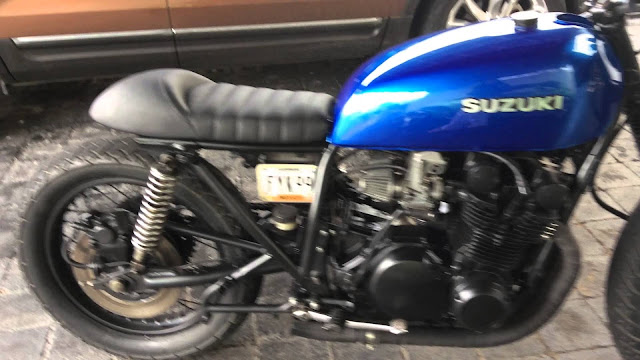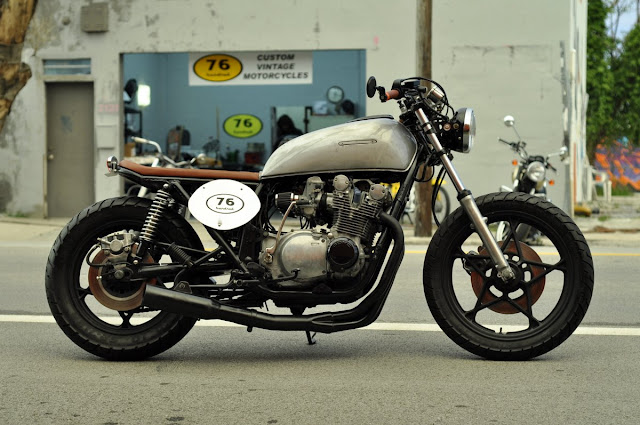Suzuki GS750
The Suzuki’s styling was smart without being remotely imaginative. There was also little that was innovative in its dohc, four- cylinder engine layout and steel-framed, twin-shock chassis. But the GS’s speed and generally high level of performance, both in a straight line and on a twisty road, meant that Suzuki’s first big four-stroke provided plenty of excitement.
Suzuki delayed for a long time before finally entering the market with a four- cylinder. four-stroke superbike in 1977, but the wait was worthwhile. The GS750 was a stunningly powerful and well-engineered bike that not only matched its rivals for speed and reliability, but surpassed them for handling. Coming from a company whose most notable previous model had been the GT750 two-stroke triple, the GS was a remarkable machine.
For all its merits the GS750 was far from the world’s most imaginative motorcycle. In the finest tradition of Japanese motorcycle design it was closely based on the best existing machine of a few years earlier, in this case Kawasaki’s Z900. The GS’s dohc air-cooled engine shared the famously powerful and strong Kawasaki’s 65mm piston diameter and even its valve sizes and timing, achieving its 748cc capacity with a shorter 56.4mm stroke. Peak output was 68bhp at 85()0rpm, making the Suzuki the most powerful 750 on the market. In contrast to the large and rather gaudy GT750 two-stroke that it was built to replace, the GS was conservatively styled, and disguised its substantial 5051b (229kg) fuelled-up weight well. There was a notable lack of fuss about the whole machine, which combined simple paintwork with black sidepanels, a slim front mudguard and a thick and effective dual-seat. The only remotely frivolous feature was a digital gear indicator in the instrument panel.
Superior chassis design
Chassis design was also conventional, based around a twin-downtube frame that outclassed several apparently similar rivals due partly to its heavily braced steering head area and needle-roller swingarm bearings. Similarly, although the front forks and twin rear shocks were of typical design, they proved to be above average in use. And the GS combined its 19-inch front and 18-inch rear wheels with a single disc brake at each end.
The brakes combined to give reasonable stopping power and they were needed, too, because the GS750 was blindingly fast. At low revs it was docile in typical Japanese four fashion, pulling smoothly from as low as 2000rpm in the highest ratio of its smooth-shifting five-speed gearbox. Once the rev-counter needle reached 6000rpm. though, the Suzuki took off in fine style, storming smoothly towards the 9500rpm redline through the gears, as it headed for a top speed of over I20mph (I93km/h).
Although the riding position was roomy and upright (especially on the American market model with its higher bars), the GS was fairly comfortable and easily powerful enough for sustained cruising at 80mph (129km. h i or more. And its handling was excellent, too. combining good >tabilit\ with agility and steering precision that matched all of its mass- produced Japanese rivals, and surpassed quite a few by a distance.
Predictably the GS was a big success, instantly establishing Suzuki as a major superbike force. It also proved commendably reliable, so much so that when the model was revised in 1979. the only notable changes were new paint schemes, cast wheels and a second front brake disc. If the GS750 had been produced by any of the experienced superbike manufacturers it would have been a triumph. Coming as Suzuki‘s first ever big four- stroke. it was truly inspired.
Smaller Four: the GS550
Suzuki moved rapidly to follow the GS750 with a middleweight four, the GS550, which appeared only a few months later in 1977. Although the similarly styled and inevitably slower 550 did not have the same impact as the bigger model, it too was an impressive machine, with a top speed of 110mph (177km/h), sound handling and superbly versatile performance. Like the GS750, it was impeccably reliable as well as competitively priced, and soon became popular.
The GS750's chassis was every bit as impressive as its smooth and powerful four-cylinder engine, and maintained stability even when the bike was being cornered at speed.
This US-market Suzuki’s high handlebars did not add to high-speed comfort. But in this form or with fatter bars, the GS was one of the world’s fastest super bikes.
Specification Suzuki GS750 (1977)
- Engine Air-cooled dohc eight-valve four
- Capacity 749cc (65 x 56.4mm)
- Maximum power 68bhp @ 8500rpm
- Transmission Five-speed, chain final drive
- Frame Steel twin downtube
- Suspension Telescopic front; twin shocks rear
- Brakes Disc front and rear
- Weight 505lb (229kg)
- Top speed I25mph (201 km/h)




















0 comments: